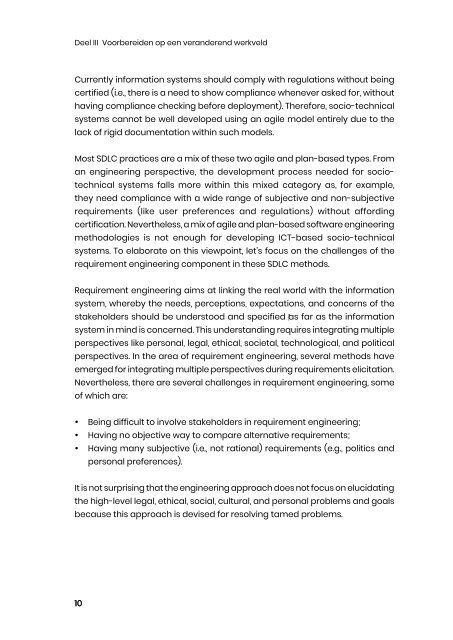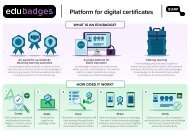13. Digital transformations and their design – renewal of the socio-technical approach
You also want an ePaper? Increase the reach of your titles
YUMPU automatically turns print PDFs into web optimized ePapers that Google loves.
Deel III Voorbereiden op een ver<strong>and</strong>erend werkveld<br />
Currently information systems should comply with regulations without being<br />
certified (i.e., <strong>the</strong>re is a need to show compliance whenever asked for, without<br />
having compliance checking before deployment). Therefore, <strong>socio</strong>-<strong>technical</strong><br />
systems cannot be well developed using an agile model entirely due to <strong>the</strong><br />
lack <strong>of</strong> rigid documentation within such models.<br />
Most SDLC practices are a mix <strong>of</strong> <strong>the</strong>se two agile <strong>and</strong> plan-based types. From<br />
an engineering perspective, <strong>the</strong> development process needed for <strong>socio</strong><strong>technical</strong><br />
systems falls more within this mixed category as, for example,<br />
<strong>the</strong>y need compliance with a wide range <strong>of</strong> subjective <strong>and</strong> non-subjective<br />
requirements (like user preferences <strong>and</strong> regulations) without affording<br />
certification. Never<strong>the</strong>less, a mix <strong>of</strong> agile <strong>and</strong> plan-based s<strong>of</strong>tware engineering<br />
methodologies is not enough for developing ICT-based <strong>socio</strong>-<strong>technical</strong><br />
systems. To elaborate on this viewpoint, let’s focus on <strong>the</strong> challenges <strong>of</strong> <strong>the</strong><br />
requirement engineering component in <strong>the</strong>se SDLC methods.<br />
Requirement engineering aims at linking <strong>the</strong> real world with <strong>the</strong> information<br />
system, whereby <strong>the</strong> needs, perceptions, expectations, <strong>and</strong> concerns <strong>of</strong> <strong>the</strong><br />
stakeholders should be understood <strong>and</strong> specified as far as <strong>the</strong> information<br />
system in mind is concerned. This underst<strong>and</strong>ing requires integrating multiple<br />
perspectives like personal, legal, ethical, societal, technological, <strong>and</strong> political<br />
perspectives. In <strong>the</strong> area <strong>of</strong> requirement engineering, several methods have<br />
emerged for integrating multiple perspectives during requirements elicitation.<br />
Never<strong>the</strong>less, <strong>the</strong>re are several challenges in requirement engineering, some<br />
<strong>of</strong> which are:<br />
• Being difficult to involve stakeholders in requirement engineering;<br />
• Having no objective way to compare alternative requirements;<br />
• Having many subjective (i.e., not rational) requirements (e.g., politics <strong>and</strong><br />
personal preferences).<br />
It is not surprising that <strong>the</strong> engineering <strong>approach</strong> does not focus on elucidating<br />
<strong>the</strong> high-level legal, ethical, social, cultural, <strong>and</strong> personal problems <strong>and</strong> goals<br />
because this <strong>approach</strong> is devised for resolving tamed problems.<br />
10


















